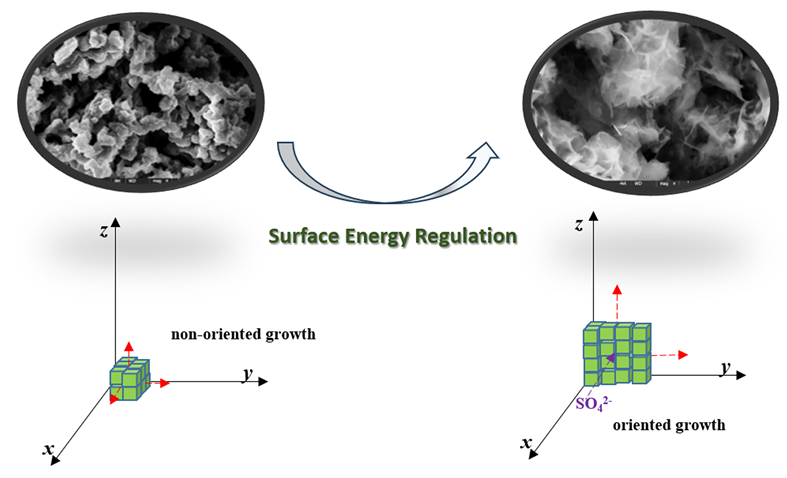| [1] |
Chen, G. X.; Huang, Q.; Wu, T.; Lu, L. Adv. Funct. Mater. 2020, 2001289.
|
| [2] |
Zeng, X. G.; Peng, J.; Guo, Y.; Zhu, H. F.; Huang, X. Front. Chem. 2020, 8, 635.
doi: 10.3389/fchem.2020.00635
|
| [3] |
Sun, C.; Deng, Z. R.; Jiang, N. B.; Zhang, L. L.; Fang, H.; Yang, X. L. Energy Storage Science and Technology 2022, 11, 1184 (in Chinese).
|
|
(孙畅, 邓泽荣, 江宁波, 张露露, Fang Hui, 杨学林, 储能科学与技术, 2022, 11, 1184.)
doi: 10.19799/j.cnki.2095-4239.2021.0719
|
| [4] |
Liu, X. H.; Feng, G. L.; Wu, Z. G.; Wang, D.; Wu, C.; Yang, L.; Xiang, W.; Chen, Y. X.; Guo, X. D.; Zhong, B. H. J. Alloy. Compd. 2019, 815, 152430.
doi: 10.1016/j.jallcom.2019.152430
|
| [5] |
Jian, Z. L.; Zhao, L.; Pan, H. L.; Hu, Y. S.; Li, H.; Chen, W.; Chen, L. Q. Electrochem. Commun. 2012, 14, 86.
doi: 10.1016/j.elecom.2011.11.009
|
| [6] |
Shen, X.; Zhou, Q.; Han, M.; Qi, X. G.; Li, B.; Zhang, Q. Q.; Zhao, J. M.; Yang, C.; Liu, H. Z.; Hu, Y.-S. Nat. Commun. 2021, 12, 2848.
doi: 10.1038/s41467-021-23132-w
|
| [7] |
Yang, J.; Han, D.-W.; Jo, M. R.; Song, K.; Kim, Y.-I.; Chou, S.-L.; Liu, H.-K.; Kang, Y.-M. J. Mater. Chem. A 2015, 3, 1005.
doi: 10.1039/C4TA06001F
|
| [8] |
Liu, Q.; Wang, D. X.; Yang, X.; Chen, N.; Wang, C. Z.; Bie, X. F.; Wei, Y. J.; Chen, G.; Du, F. J. Mater. Chem. A 2015, 3, 21478.
doi: 10.1039/C5TA05939A
|
| [9] |
Wang, P. Y.; Zhang, X. L.; Xu, J. Q. New Chemical Materials 2007, 35, 14 (in Chinese).
|
|
(王培义, 张晓丽, 徐甲强, 化工新型材料, 2007, 35, 14.)
|
| [10] |
Xu, W. J.; Jia, J.; Wang, T.; Li, C.; He, B. W.; Zong, J. P.; Wang, Y. W.; Fan, H. J.; Xu, H. X.; Feng, Y. H.; Chen, H. Y. Angew. Chem., Int. Ed. 2020, 59, 22246.
doi: 10.1002/anie.v59.49
|
| [11] |
Jia, J.; Liu, G. Y.; Xu, W. J.; Tian, X. L.; Li, S. B.; Han, F.; Feng, Y. H.; Dong, X. C.; Chen, H. Y. Angew. Chem., Int. Ed. 2020, 59, 14443.
doi: 10.1002/anie.v59.34
|
| [12] |
Chen, T.; Yang, Y.; Zhao, W. Y.; Pan, D. Q.; Zhu, C. T.; Lin, F. Y.; Guo, X. Y. Acta Chim. Sinica 2019, 77, 447 (in Chinese).
doi: 10.6023/A19010033
|
|
(陈甜, 杨英, 赵婉玉, 潘德群, 朱从潭, 林飞宇, 郭学益, 化学学报, 2019, 77, 447.)
doi: 10.6023/A19010033
|
| [13] |
Wang, H. X.; Yang, G.; Cheng, T. S.; Wang, N.; Sun, R.; Wong, C.-P. Acta Chim. Sinica 2019, 77, 316 (in Chinese).
doi: 10.6023/A18110456
|
|
(王海旭, 杨光, 程天舒, 王宁, 孙蓉, 汪正平, 化学学报, 2019, 77, 316.)
doi: 10.6023/A18110456
|
| [14] |
Zhang, G. X.; Chen, Y. M.; He, Z.-N.; Lin, C.; Chen, Y.-G.; Guo, H.-B. Journal of Inorganic Materials 2018, 3, 289 (in Chinese).
|
|
(张国雄, 陈月梅, 何臻妮, 林川, 陈益钢, 郭海波, 无机材料学报, 2018, 3, 289.)
|
| [15] |
Fang, Y. J.; Liu, Q.; Xiao, L. F.; Rong, Y. C.; Liu, Y. D.; Chen, Z. X.; Ai, X. P.; Cao, Y. L.; Yang, H. X.; Xie, J.; Sun, C. J.; Zhang, X. Y.; Aoun, B.; Xing, X. R.; Xiao, X. H.; Ren, Y. Chem 2018, 4, 1.
doi: 10.1016/j.chempr.2017.12.021
|
| [16] |
Shen, X.; Han, M.; Li, X. W.; Zhang, P.; Yang, C.; Liu, H. Z.; Hu, Y.-S. ACS Appl. Mater. Interfaces 2022, 14, 6841.
doi: 10.1021/acsami.1c22655
|
| [17] |
Qi, Y. R.; Tong, Z. Z.; Zhao, J. M.; Ma, L.; Wu, T. P.; Liu, H. Z.; Yang, C.; Lu, J.; Hu, Y.-S. Joule. 2018, 2, 1.
doi: 10.1016/j.joule.2017.10.014
|
| [18] |
Zhang, D. B.; Kong, X. G.; Jiang, M. H.; Lei, D. Q.; Lei, X. D. ACS Sustainable Chem. Eng. 2019, 7, 4420.
doi: 10.1021/acssuschemeng.8b06386
|
 ), 袁欣然a, 辛亚男b, 刘天豪a, 韩慧果b, 杜光超c, 滕艾均a,*(
), 袁欣然a, 辛亚男b, 刘天豪a, 韩慧果b, 杜光超c, 滕艾均a,*( )
)
 ), Xinran Yuana, Yanan Xinb, Tianhao Liua, Huiguo Hanb, Guangchao Duc, Aijun Tenga(
), Xinran Yuana, Yanan Xinb, Tianhao Liua, Huiguo Hanb, Guangchao Duc, Aijun Tenga( )
)
